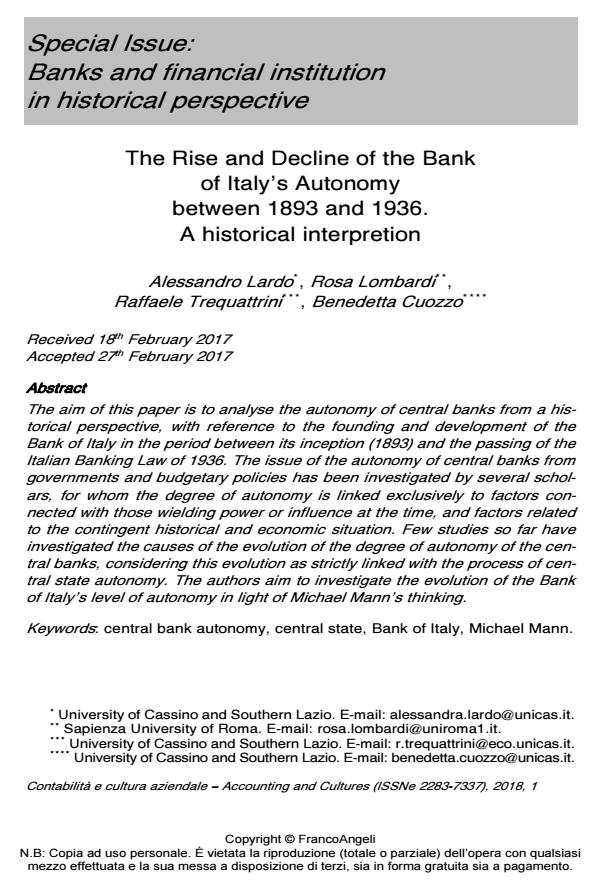The Rise and Decline of the Bank of Italy’s Autonomy between 1893 and 1936. A historical interpretion
Titolo Rivista CONTABILITÀ E CULTURA AZIENDALE
Autori/Curatori Alessandro Lardo, Rosa Lombardi, Raffaele Trequattrini, Benedetta Cuozzo
Anno di pubblicazione 2018 Fascicolo 2018/1
Lingua Inglese Numero pagine 23 P. 13-35 Dimensione file 240 KB
DOI 10.3280/CCA2018-001003
Il DOI è il codice a barre della proprietà intellettuale: per saperne di più
clicca qui
Qui sotto puoi vedere in anteprima la prima pagina di questo articolo.
Se questo articolo ti interessa, lo puoi acquistare (e scaricare in formato pdf) seguendo le facili indicazioni per acquistare il download credit. Acquista Download Credits per scaricare questo Articolo in formato PDF

FrancoAngeli è membro della Publishers International Linking Association, Inc (PILA)associazione indipendente e non profit per facilitare (attraverso i servizi tecnologici implementati da CrossRef.org) l’accesso degli studiosi ai contenuti digitali nelle pubblicazioni professionali e scientifiche
The aim of this paper is to analyse the autonomy of central banks from a historical perspective, with reference to the founding and development of the Bank of Italy in the period between its inception (1893) and the passing of the Italian Banking Law of 1936. The issue of the autonomy of central banks from governments and budgetary policies has been investigated by several scholars, for whom the degree of autonomy is linked exclusively to factors connected with those wielding power or influence at the time, and factors related to the contingent historical and economic situation. Few studies so far have investigated the causes of the evolution of the degree of autonomy of the central banks, considering this evolution as strictly linked with the process of central state autonomy. The authors aim to investigate the evolution of the Bank of Italy’s level of autonomy in light of Michael Mann’s thinking.
Parole chiave:Central bank autonomy, central state, Bank of Italy, Michael Mann.
- Industry self-regulatory institutions, accounting and imitation mechanisms: the case of the ‘Unione Commercianti in Manifatture di Milano’ Carmelo Marisca, Gustavo Barresi, Nicola Rappazzo, in Accounting History Review /2022 pp.31
DOI: 10.1080/21552851.2022.2089703 - Banks and financial institutions in historical perspective Valerio Antonelli, Nieves Carrera, Christopher Napier, in CONTABILITÀ E CULTURA AZIENDALE 1/2018 pp.9
DOI: 10.3280/CCA2018-001002
Alessandro Lardo, Rosa Lombardi, Raffaele Trequattrini, Benedetta Cuozzo, The Rise and Decline of the Bank of Italy’s Autonomy between 1893 and 1936. A historical interpretion in "CONTABILITÀ E CULTURA AZIENDALE" 1/2018, pp 13-35, DOI: 10.3280/CCA2018-001003